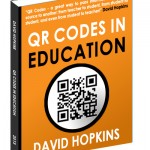QR Codes: Learning Technology
 Update: If you’re interested in QR Codes, then you would do well to get my book QR Codes in Education, available as paperback or eBook.
Update: If you’re interested in QR Codes, then you would do well to get my book QR Codes in Education, available as paperback or eBook.
Since I starting looking into QR Codes and how they can be used in Higher Education (library’s, classrooms, museums, induction, etc) there has been one name that keeps coming up in all my searches: Andy Ramsden at Bath University.
His blog QR Codes at Bath makes for great reading for anyone interested. He writes on all aspects of the uses of QR Codes from Conference badges, Museums, and ticketing to uses in educational context.
His presentation ‘QR codes as a learning technology‘, given at the Plymouth eLearning Conference in 2009 explores the uses of QR Codes in education. It is a must-read for anyone looking for background or uses of this growing technology – while it may be a ‘fad’ at the moment, it has the potential to be so much more.
Another excellent presentation on the use of QR Codes in education and learning is from Australian, John Sandler – ‘QR Codes: tagging for learning performance‘
I can see that QR Codes is not something that will be easy to implement into an eLearning scenario, but the ability to link the physical world to the virtual one is made all that little bit easier with QR Codes.
What can QR Codes do for education? This is from the Educause wiki on QR Codes:
“QR codes link the physical world with the virtual by providing on-the-spot access to descriptive language and online resources for objects and locations. In this way, the codes support experiential learning, bringing scholarship out of the classroom and the computer and into physical experience.”
QR Codes in the Classroom
“Faculty members might include a QR Code on their PowerPoint presentation which links to the slidedeck stored online. Instead of remembering a long URL, students could just scan the code with their mobile phone as they leave the campus.”
QR Codes on Campus
“Students in an architecture course might be charged with the task of created Web pages for each building on campus that describe the history of the building and the styles utilized. A QR code might be added to each building sign that links to those descriptive pages. During campus tours, students and parents might be encouraged to ‘explore’ using handheld QR code readers.”
It is also worth spending about 10 minutes reading through this Educause “7 Things You Should Know About QR Codes” report which summarises that:
“the codes support experiential learning, bringing scholarship out of the classroom and into physical experience … [and] the greatest importance of QR codes could lie not in their specific use, which may be superseded by newer codes and interpreters, but in the opportunities they offer for moving away from keyboards as input devices in learning environments.”
To finish this little jaunt into the world of QR Codes in education, Andy Ramsden is looking into the ways in which these codes can be used “within an integrated solution to record and monitor the submission (physical hand-in) of assignments” (Andy Ramsden, Thinking Ahead …). I am also very interested in the scripts he mentions, written by Blazej Zieba:
- “Mobile Virtual Guide” – web application which allows you to create a virtual tour and generate QR Codes to mark locations, and
- “Mobile 2d Code Hunt” – web application which allows you to create urban games.
Amazing work and something I’ll be trying when I can get it hosted – follow me on Twitter or subscribe to the blog or RSS feed for updates. Please feel free to comment or question as well.


















Many thanks for this – lots of useful resources. Your last blog post on QR codes sparked off a heap of activity at QMU with myself and a couple of colleagues. We have now started trialling using QR codes to allow students to download mp3/mp4 files from WebCT to their phones. Early days so no feedabck as yet but I can envisage that we will do further trials in this area.
Thanks Graeme. The trick is getting the technology working as well as getting people to understand the benefits as well as modifying their teaching habits to incorporate it into their day-to-day work.
I’d be interested if you let me know how you get on at QMU, so please keep in touch.
Regards, David.
Hi,i am Jon Milton i read your blog and i got much knowledge from your blog,i think this is the most suitable blog for me.
Jon.